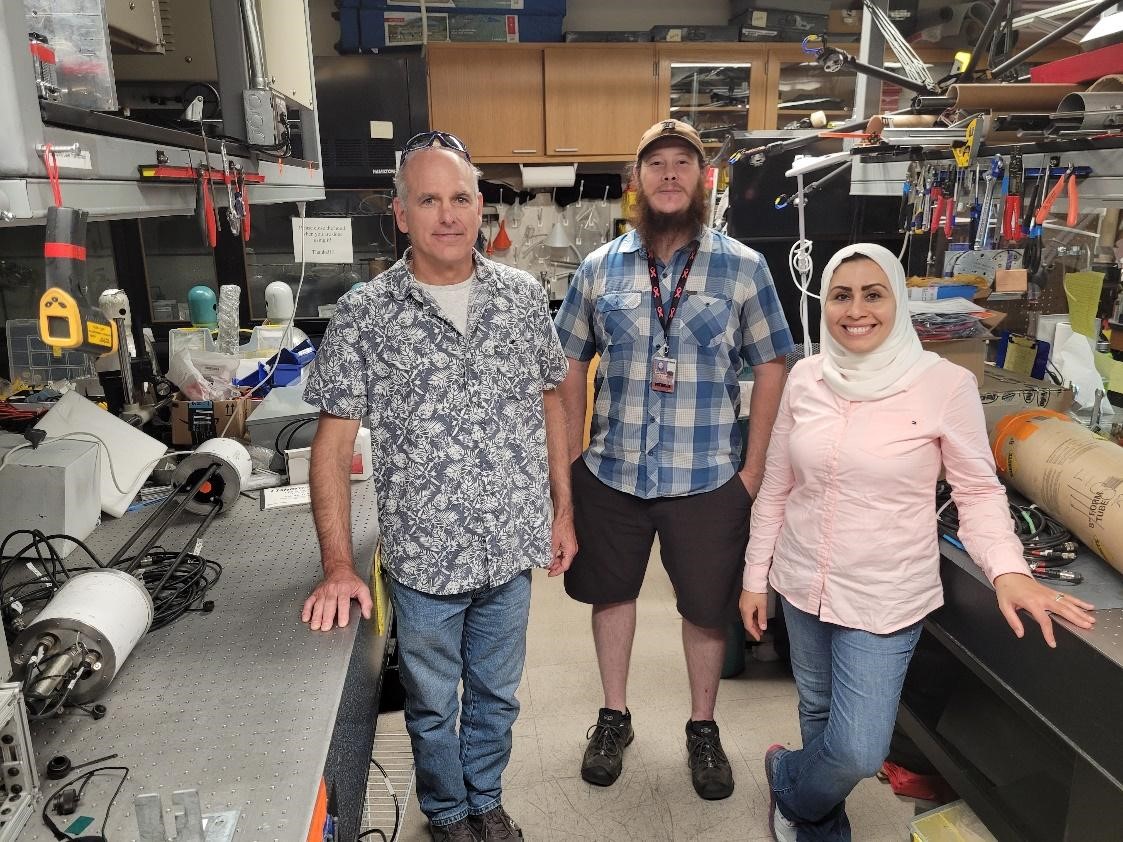ARL Weekly News – June 16, 2023
| Recent Events |
Visit the Department of Civil and Environmental Engineering at Princeton University
ARL team members at the Department of Civil and Environmental Engineering, Princeton University, from left to right: Paul Kelley, Phillip Stratton and Nebila Lichiheb. On Friday June 16, 2023, Nebila Lichiheb, Phillip Stratton and Paul Kelley visited the Department of Civil and Environmental Engineering at Princeton University and met with Lars Wendt and Hongming Yi. The purpose of the visit was to test the novel open-path NH3 sensor developed by Professor Mark Zondlo’s group and deploy it on the roof of ARL’s Air Resources Car – a Chevrolet Suburban SUV – to measure the spatial and temporal variation of NH3 concentrations in the targeted areas within the AEROMMA campaign.

ARL team members at the Department of Civil and Environmental Engineering, Princeton University, from left to right: Paul Kelley, Phillip Stratton and Nebila Lichiheb.
Atmospheric Transport and Dispersion Modeling Conference held June 20-22
A number of ARL researchers presented at the 27th annual conference on Atmospheric Transport and Dispersion Modeling. Held at George Mason, the conference will cover a wide range of atmospheric transport and dispersion modeling topics and applications. At a HYSPLIT session Chris Loughner, Alice Crawford, Fantine Ngan, and Miguel Cahuich presented. Binyu Wang and Jeff McQueen of NWS also presented in the session regarding HYSPLIT-related work. Chris Loughner chaired the HYSPLIT session.


Atmospheric Composition Workshop held June 22.
Patrick Campbell also organized a mini-workshop to bring together atmospheric composition and air quality modeling collaborators from the greater-DC area to present and discuss ongoing and emerging research and development in the areas of Emissions and Air Quality Modeling, Observations, and Data Fusion. The workshop was co-organized with the 27th Annual GMU Conference on Atmospheric Transport & Dispersion Modeling. The program will cover the following topics:
- Session 1: Emissions inventories and modeling
- Session 2: Air quality modeling, forecasting, reanalysis and applications
- Session 3: In-situ and satellite observations, data assimilation, and model-observation fusion.
| Upcoming Events |
Tianfeng Chai will attend the CTBT: Science and Technology conference series, SnT2023, June 19-23, Virtually.
Alice Crawford will attend, virtually, the 9th NAME User Workshop at the Met Office, Exeter on Monday 26th and Tuesday 27th June, 2023.
| Publications |
Published: Surf, turf, and above the Earth: Unmet needs for coastal air quality science in the planetary boundary layer (PBL).
Sullivan, J. T., Stauffer, R. M., Thompson, A. M., Tzortziou, M. A., Loughner, C. P., Jordan, C. E., & Santanello, J. A. (2023). Surf, turf, and above the Earth: Unmet needs for coastal air quality science in the planetary boundary layer (PBL). Earth’s Future, 11, e2023EF003535. https://doi.org/10.1029/2023EF003535
Abstract: Coastal areas are some of the most densely populated and economically important regions in the world. As such, protecting the health of the human population and ecosystems at the coastal interface and understanding the impacts of environmental stressors such as air pollutants provides wide-ranging benefits. Air quality (AQ) processes within coastal regions have been studied using ground and space-based platforms, with intensive field campaigns focused on addressing key science questions that are typically partitioned into either direct atmospheric effects (e.g., anthropogenic emissions creating air pollution) or indirect processes and feedback loops (e.g., terrestrial/marine biogenic processes modifying atmospheric properties). The atmospheric planetary boundary layer (PBL) and its depth (or height) connect land, air, and the water surface via many pathways, especially with transport and exchange processes tied to the complexities of the coastal interface. We still cannot accurately characterize—through field, aircraft, or space-based observations—the spatial and temporal PBL variability and processes within the PBL that couple together coastal dynamics and air quality. Several upcoming geostationary and polar-orbiting satellite missions are likely to make significant progress in characterizing these air/land/water interactions over the next decade. Here, we present a framework of the current understanding of the PBL’s role in coastal regions, primarily regarding air quality and atmospheric deposition, to motivate future concerted efforts from ground- and space-based platforms to achieve a holistic understanding of the coastal interface.
Published: The Influence of Synoptic-Scale Wind Patterns on Column-Integrated Nitrogen Dioxide, Ground-Level Ozone, and the Development of Sea-Breeze Circulations in the New York City Metropolitan Area
Nauth, D., C. P. Loughner, and M. Tzortziou, 2023: The Influence of Synoptic-Scale Wind Patterns on Column-Integrated Nitrogen Dioxide, Ground-Level Ozone, and the Development of Sea-Breeze Circulations in the New York City Metropolitan Area. J. Appl. Meteor. Climatol., 62, 645–655, https://doi.org/10.1175/JAMC-D-22-0145.1.
Abstract: The continually changing atmospheric conditions over densely populated coastal urban regions make it challenging to produce models that accurately capture the complex interactions of anthropogenic and environmental emissions, chemical reactions, and unique meteorological processes, such as sea- and land-breeze circulations. The purpose of this study is to determine and identify the influence of synoptic-scale wind patterns on the development of local-scale sea-breeze circulations and air quality over the New York City (NYC), New York, metropolitan area. This study utilizes column-integrated nitrogen dioxide observations made during the Long Island Sound Tropospheric Ozone Study (LISTOS) field campaign, ground-level ozone observations, the HRRR numerical weather prediction model, and trajectory model simulations using the NOAA HYSPLIT model. A cluster analysis within the HYSPLIT modeling system was performed to determine that there were six unique synoptic-scale transport pathways for NYC. Stagnant conditions or weak transport out of the northwest resulted in the worst air quality for NYC. Weak synoptic-scale forcings associated with these conditions allowed for local-scale sea-breeze circulations to develop, resulting in air pollution being able to recirculate and mix with freshly emitted pollutants.

